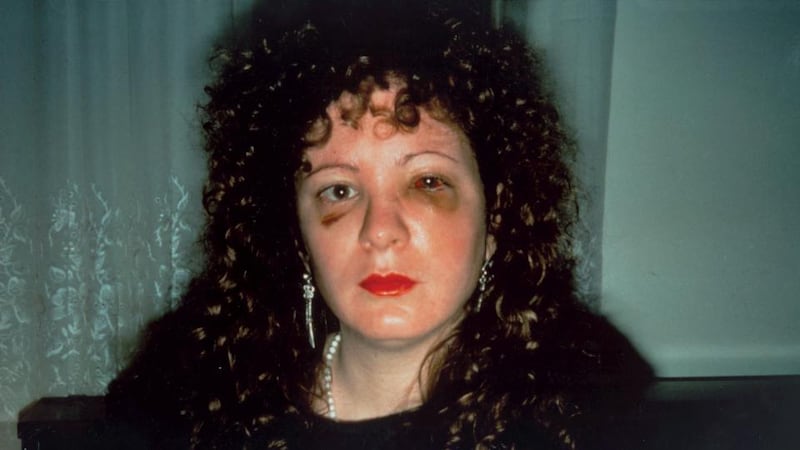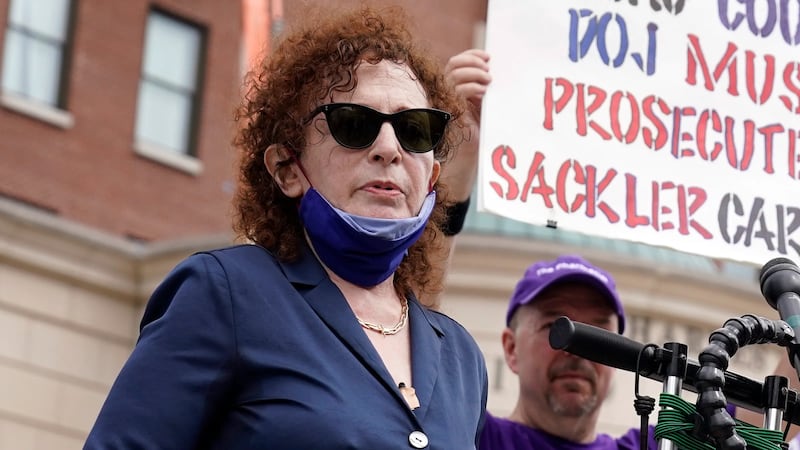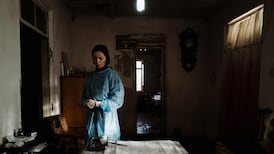Not many people were betting on Laura Poitras’s All the Beauty and the Bloodshed to win the Golden Lion at last September’s Venice Film Festival. It wasn’t just that titles such as Tár, The Banshees of Inisherin and Saint Omer were picking up good word. Poitras’s documentary, weaving a biography of Nan Goldin in with a study of that photographer’s campaign against one corner of Big Pharma, had also received raves from all directions. But only one documentary had won in the festival’s 76-year history. (Cannes hasn’t even presented a doc in competition for over a decade.) In the event, All the Beauty and the Bloodshed followed in the footsteps of Rashomon, The Battle of Algiers and Brokeback Mountain to take the Lion.
“Just playing a competition was such an honour,” Poitras says. “I talk a lot about issues in my films. But I believe in cinema. It meant so much just to premiere in Venice, a festival I revere. I was thrilled with that alone. Receiving the Golden Lion really wasn’t on our radar. I was just thrilled to be here. I just think it’s important that we remember documentary cinema.”
How does that work on the evening? The winners are, I imagine, lured back with some vague promise.
“You are encouraged to be there,” she says enigmatically.
‘Forget about glamour’: Jonathan Anderson offers advice to would-be fashion designers as he receives TCD honour
Death of Pope Francis: Derek Mooney leads RTÉ’s coverage to intermittently jaw-dropping effect
Chob Thai restaurant, Clontarf: The most memorable thing here is the bill
Careless People: The controversial book is shocking and reveals Facebook is far worse than we could have suspected
Poitras could hardly be a more appropriate person to stand up for a new vibrancy in documentary filmmaking. Raised largely in Massachusetts, she broke through in 2003 with Flag Wars, a study of gentrification in Columbus, Ohio. My Country, My Country, treating Iraq under US occupation, was nominated for an Academy Award in 2006, but it was Citizenfour that really made her name. The study of Edward Snowden beat hot competition to take the 2014 Oscar for best documentary and scared up a torrent of controversy.
The current project is notable for weaving two linked strands into an impressively seamless fabric. One details the rise of Goldin from middle-class childhood in suburbia to life among New York bohemians in the Aids years to her current status as an eminent legend. The picture touches on a difficult relationship with her mother and later encounters with abusive partners. Initially suspicious of her confessional style, the artistic establishment took a long time to come round to Goldin’s raw, now iconic photographs.
The other strand details her efforts to force Purdue Pharma, then run by the influential Sackler family, to take its share of responsibility for the opioid epidemic. Goldin had herself become addicted to OxyContin, a Purdue product, after being prescribed the drug to ease wrist pain. Her particular concern was the Sacklers’ named sponsorship of such cultural institutions as the Louvre, the Guggenheim Museum and the Metropolitan Museum of Art in New York City. The campaign by Pain – Prescription Addiction Intervention Now – eventually led to the Sacklers’ name being taken off the Met’s Temple of Dendur room. Others followed.
I had read that Goldin was looking for someone to tell her story, and settled on Poitras.
“When Nan started Pain, they documented their actions,” Poitras explains. “I had a chance breakfast with them and they told me. I was so excited. I’m the geek documentarian. I always have a camera. I said: ‘Anything I can do to help.’ They were looking to invite others to come on board – to bring financing and to finish it. I was thrilled. I am really interested in films about individuals who are causing change and taking risks. I like films that are about a person and are also about a larger social issue.”
It’s super-important to remember that what she was doing was radical – turning the camera on her life. And it wasn’t embraced by everyone
— Laura Poitras on Nan Goldin
One can easily imagine this being two films. One could equally imagine one of the two lines – the activism or the artistic career – being downgraded to a knotty subplot. But All the Beauty and the Bloodshed allows both equal prominence. I wonder if that was always the idea.
“I think that happened over time,” Poitras says. “I don’t really think of it as a biography. I consider it a portrait more than a biography. I knew that that was going to happen after we started doing these interviews. Nan and I did these audio interviews. It became really moving. How she talked about her life and her work. Working with great editors like Joe Bini – he worked with Lynne Ramsay and Werner Herzog – he saw this inner story/outer story balance. It emerged in the editing process. As a filmgoer, I love stories that are built on juxtapositions.”
[ Nan Goldin and Vivienne Dick: extraordinary art, extraordinary friendshipOpens in new window ]
[ Empire of Pain: America’s opioid crisis and the family behind itOpens in new window ]
That structure certainly lends the film a captivating dynamism. We are forever flitting across the decades.
“I love going from the Guggenheim action and then cutting to her first coming to New York, before she was established. That just has so much energy. And frankly there aren’t many people who have such a document of their life.”
It is interesting for us now to hear how resistant the New York art world was then to Goldin’s style of personal, confessional expression. It is now commonplace for photographers, painters and filmmakers to explore their personal traumas directly. But even arriving after the convulsions of the 1960s, Goldin struggled to be taken seriously. She is now seen as a vital chronicler of LGBT and wider bo-ho life in the 1970s and 1980s. The work is immediate and indisputable. It is now unavoidably there.
“Basically, the pushback she got was ‘There is no such thing as a great woman artist’,” Poitras says. “It’s super-important to remember that what she was doing was radical – turning the camera on her life. And it wasn’t embraced by everyone. A lot of people felt: ‘What’s this?’ Nan points the camera towards her life, but she does it at a personal cost. I’m thinking about the images of her being battered. That was really brave. This is the sort of thing many people don’t talk about to their close friends. That was ground-breaking.”

The portrait of New York in the post-punk years is, to say the least, bittersweet. All the Beauty and the Bloodshed is, to an extent, celebration of a vanished Manhattan. This was an era when it was still possible for penniless artists to set up home in a rundown part of the island and welcome whole armies of fellow travellers. The Bowery was awash with alternative culture and rough-hewn, seat-of-the-pants glamour. Gentrification wiped out those opportunities. More grimly still, Aids took away so many of the personalities.
“I agree. Think of the all the people we lost,” she says. “That Nan lost. It’s staggering. It’s… Aww…”
They have been shamed. Nan has succeeded in having their names removed from all these institutions. I don’t think it would have happened without her
— Laura Poitras
She seems faintly lost for words.
“It would be a different world. Right? I’m thinking about the art world – the devastation that happened with Aids. It’s hard to even begin to comprehend.”
So what exactly did Goldin’s campaign against the Sackler family achieve? The film opens with Pain activists chanting “Sacklers lie, people die”, and then lying as if dead in what was then the Sackler Wing in the Metropolitan Museum. The film alleges that the family anticipated a “blizzard” of OxyContin prescriptions after the drug emerged. The protesters reference that by dropping sheaves of paper during their occupations. All the Beauty and the Bloodshed ends with members of the Sacklers being forced to confront the family of victims on a video call. Their names have gone from prominent museums. Did Goldin and her co-protesters win a battle or a skirmish… or maybe a war?
“First of all, none of the Sacklers are facing any criminal exposure. None of them had to file for bankruptcy. They syphoned their money out of the company. It is still about impunity. They haven’t been held accountable. But they have been shamed. They have been shamed. Nan has succeeded in having their names removed from all these institutions. I don’t think it would have happened without her. When she started this, the museums didn’t respond. The Met did not respond. The Guggenheim did not respond.”
Interestingly, the first crack emerged not in New York, but in London.
“After about a year, it was the National Portrait Gallery that responded,” Poitras says. “They deserve a lot of credit. They were the first ones to reject the money. They were going to do a retrospective on Nan and she said: ‘If you want the retrospective you have to reject the money.’ And they did.”

So what could be the wider ramifications of the campaign? Do we expect cultural institutions to think harder about what benefactor’s name they slap on their latest wing? That would be a significant change. Slave owners, arms manufacturers and any number of everyday exploiters have enjoyed immortalisation (or so they thought) in the names of libraries, galleries and university lecture halls.
“I do think that it will shift things,” Poitras says. “I talked to somebody who said there need to be clauses in contracts. Your name can’t be there in perpetuity if, say, it’s found to be that your money is revealed to be involved with mass death, for instance.”
All the Beauty and the Bloodshed is now part of that campaign. Documentaries connect more with the public than they once did. And Poitras’s win at Venice only helps kick down the doors.
“As documentary filmmakers, we’re making cinema and we’re telling stories, in the same way you are with a scripted film,” she says. “There is now more understanding that documentaries do that just as novels do.”
It has taken a while for that message to get through.
All the Beauty and the Bloodshed opens on January 27th














